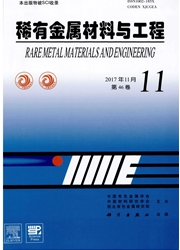

 中文摘要:
中文摘要:
采用悬浮熔炼-水冷铜模吸铸法制备Cu_(50)Zr_(42)Al_8锥形试样,研究了合金不同直径处的组织和微观力学行为,分析了尺寸效应和裂纹自愈合行为。结果表明,复合材料组织中包括非晶基体相、金属间化合物Al Cu_2Zr相、奥氏体B_2-Zr Cu相和热致马氏体B19’-Zr Cu相。纳米压痕结果表明,单一非晶结构的试样心部硬而表面较软,呈现越小越软趋势,而较大尺寸的非晶复合材料由于析出相的存在,心部软而表面较硬。形状记忆晶相由TRIP效应对非晶基体增强增韧,而Al Cu_2Zr相析出使基体脆化。经150℃/10 min退火后,微观压痕产生的裂纹表现出自愈合行为。加载时,形变诱导B2奥氏体向B19’马氏体相转变并伴随着体积的膨胀,而高于逆转变温度退火,B19’转变为B2相,体积收缩并在组织应力作用下驱动裂纹愈合。
 英文摘要:
英文摘要:
Tapered Cu_(50)Zr_(42)Al_8 alloy with good glass-forming ability was fabricated by copper mould suction casting. Cubic Al Cu_2 Zr and B_2-Zr Cu, thermal-induced martensitic B19'-Zr Cu phases form on the glass matrix along the radial direction structure.Size effects on micro-mechanical properties and a unique crack healing behavior were studied. Micro-hardness of monolithic bulk metallic glass(BMG) displays "smaller is softer" trend, that is, the softer surface and the harder center. Whereas the lager size composites possess a softer center and a harder surface, due to the integrative action of the secondary phases. Amorphous matrix is toughened by TRIP(transition induced plasticity) effect of shape-memory phase as well as weakened and embrittled by Al Cu_2 Zr crystal. After annealing, self-healing of Vickers indentation crack occurs as the thermoelastic transformation of shape-memory crystals. As loading, stress-induced martensites transform from B_2 to B19', along with volume expansion. Annealed upon the reverse transformation temperature, B19' to B_2 transform accompanied by a volume shrinkage, and a restoring force from the structure stress is set up to drive the crack closure.
 同期刊论文项目
同期刊论文项目
 同项目期刊论文
同项目期刊论文
 期刊信息
期刊信息
